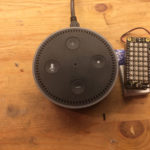I think overall this was a successful study. The goal of it was to try out different toolchains, and think about my overall technology palette going forward, and I believe I accomplished that. I’ve also managed to put together a very good list of resources, and a personalized knowledge base which is really going to help me out over the next year. The thing I want most out of my time at OCAD is to work on building my practice. I think the things I’ve done before coming here, the things I do here, and hopefully the things I will do after being here, are part of the same mesh, and this study was helpful in drawing some connections for myself.
One of the things I found I’m very interested in, is how the canned / marketed experience of using IoT products and dev toolchains is VS the roll-your-own world, and where they cross. How are people mix and matching them? How are they working around implemented limits? What are they making?
There’s still a lot of things that can be explored, but narrowing down to focusing on the Personal Assistants, was also pretty helpful. I’m starting to think more about how these things work in a system, and what kind of toolchain I can make for myself over the next year to help with my own projects. This study also gave me a view about what I can realistically accomplish in just a week.
I’m interested to see where this will go in the upcoming year.




